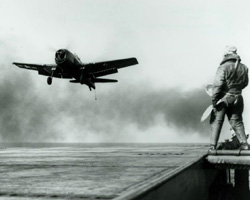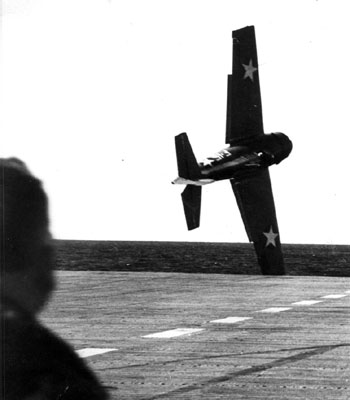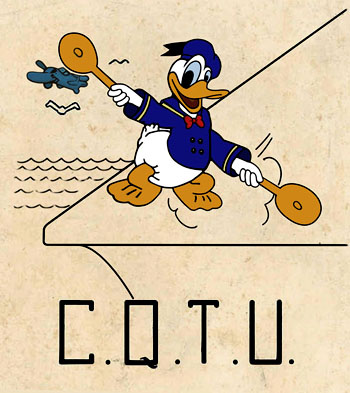USS Wolverine (IX-64) and USS Sable (IX-81)
In the wake of Pearl Harbor, with only six fleet carriers in combat, and thirteen additional fleet carriers and scores of escort carriers on order or under construction (with more to come), the U.S. Navy needed thousands of pilots and tens of thousands of deck crews qualified for carrier operations. Training these aviation pilots in the basics was relatively easy using land-based airfields. But the only way for them to be carrier qualified was to train on aircraft carriers, and that was the problem. The solution was the paddle wheel carriers USS Wolverine and USS Sable. The Navy's six existing carriers couldn’t be spared for training. Even if one were, it would be vulnerable to submarine attack. Anticipating such a need and situation in early 1941, Cmdr.. Richard F. Whitehead, aviation aide at the Great Lakes Training Center at Glenview Naval Air Station north of Chicago, offered to the Bureau of Ships the answer; convert Great Lakes steamers into aircraft carriers and conduct pilot and deck crew training in the secure waters of Lake Michigan. The Bureau of Ships ignored him. The idea resurfaced following Pearl Harbor and landed on the desk of Chief of Naval Operations Adm. Ernest J. King. Orders were cut and on March 2, 1942, at a cost of $756,000, the Navy requisitioned from the Cleveland and Buffalo Transit Company the passenger ship Seeandbee. It was joined on Aug. 7, 1942, by the Greater Buffalo. As it was, the Navy’s "Corn Belt Fleet" was born. |
||
|
|
||
|
The Seeandbee and Greater Buffalo were coal-burning, side paddlewheel, inland excursion steamers outfitted with luxurious amenities for its passengers traveling the Great Lakes. When the Navy converted these steamers in 1942 and 1943. The plush appointments, which included elegant mahogany paneling, padded furniture and more than 400 fancy bathrooms, were the first to go as refitters stripped away the splendor while converting into no-nonsense training vessels. On Aug. 12, 1942, the Seeandbee was commissioned the USS Wolverine (IX 64), its name in honor of Michigan, the Wolverine State. The Greater Buffalo was commissioned the following year on May 8, 1943, as the USS Sable (IX 81). The flight decks for the two training carriers were 500-feet and 535-feet long (about two-thirds length of fleet carriers) and equipped with eight sets of arresting gear. The ships’ islands were configured to resemble those of the combat carriers, but were not fitted with hangars, maintenance facilities, elevators, or catapults. Nor were the hulls armored, as they would never leave the waters of Lake Michigan. The Wolverine’s flight deck was constructed out of oak planks, similar to what was then in use on the combat carriers. In addition to its role as a training ship, the Sable functioned as a test bed. It was the first carrier equipped with a then-experimental metal flight deck. Various non-skid deck coatings, applied in checkerboard fashion, were evaluated. In addition, the Sable conducted tests of the experimental TDR-1, a remote controlled drone made of wood and originally designed as a target aircraft. Later tests had the drones equipped with bombs and television cameras, making them the first TV-guided missiles. The success of these tests saw the TDR-1 go into combat in 1943 at Bougainville, part of a top-secret operation conducted for the rest of the war. The ships were docked at the Navy Pier in downtown Chicago and would leave at dawn for flight operations conducted about a mile offshore. For a trainee to be carrier qualified, he had to successfully take off and land ten times (later reduced to eight). Traffic jams were regular occurrences as drivers along Lake Shore Drive stopped to watch. From dawn to dusk, seven days a week, weather and wind conditions permitting, the Corn Belt Fleet trained pilots and deck crews. Pilots were instructed to keep the canopy open in the event they ended up in water and had to escape a sinking airplane, which made flights during the winter particularly grueling. During the years of the carriers’ operations, there were 128 losses and over 200 accidents. Although the majority of losses resulted in only minor injuries, a total of eight pilots were killed. These numbers seem significant until it is considered that during that time over 120,000 successful landings took place, and an estimated 35,000 pilots qualified. In this light, the training program was a huge success. One such pilot to qualify on one of these carriers was 20-year-old and future President of the United States, George H. W. Bush. He completed his aircraft carrier landings and takeoffs on the USS Sable in August 1943. |
||
|
|
||
|
These organizations are dedicated to the preservation of naval aviation history and highly deserving of contributive support. Pritzker Military Museum & Library • Naval Aviation Museum Foundation |




